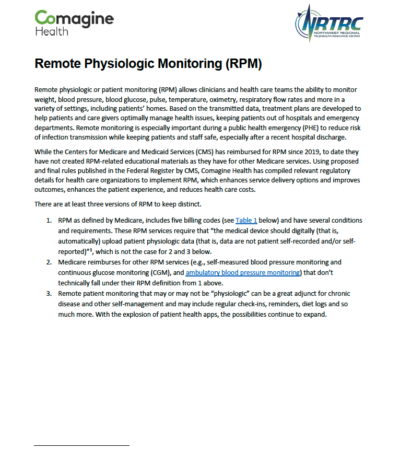Fact Sheets
Remote Physiologic Monitoring (RPM)
Remote physiologic or patient monitoring (RPM) allows clinicians and health care teams the ability to monitor weight, blood pressure, blood glucose, pulse, temperature, oximetry, respiratory flow rates and more in a variety of settings, including patients’ homes. Based on the transmitted data, treatment plans are developed to help patients and care givers optimally manage health issues, keeping patients out of hospitals and emergency departments. Remote monitoring is especially important during a public health emergency (PHE) to reduce risk of infection transmission while keeping patients and staff safe, especially after a recent hospital discharge.
While the Centers for Medicare and Medicaid Services (CMS) has reimbursed for RPM since 2019, to date they have not created RPM-related educational materials as they have for other Medicare services. Using proposed and final rules published in the Federal Register by CMS, Comagine Health has compiled relevant regulatory details for health care organizations to implement RPM, which enhances service delivery options and improves outcomes, enhances the patient experience, and reduces health care costs.
There are at least three versions of RPM to keep distinct.
- RPM as defined by Medicare, includes five billing codes (see Table 1 below) and have several conditions and requirements. These RPM services require that “the medical device should digitally (that is, automatically) upload patient physiologic data (that is, data are not patient self-recorded and/or self- reported)”1, which is not the case for 2 and 3 below.
- Medicare reimburses for other RPM services (e.g., self-measured blood pressure monitoring and continuous glucose monitoring (CGM), and ambulatory blood pressure monitoring) that don’t technically fall under their RPM definition from 1 above.
- Remote patient monitoring that may or may not be “physiologic” can be a great adjunct for chronic disease and other self-management and may include regular check-ins, reminders, diet logs and so much more. With the explosion of patient health apps, the possibilities continue to expand.

